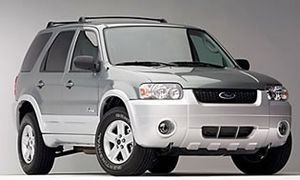.
Ford Escape Hybrid: Difference between revisions
No edit summary |
|||
| Line 20: | Line 20: | ||
===Pricing=== | ===Pricing=== | ||
<table border=1 bordercolor=#000008> | |||
<tr bgcolor=#ccccc> | |||
<td colspan=2> | |||
'''Trim''' | |||
</td> | |||
</tr> | |||
<tr bgcolor=ffffcc> | |||
<td> | |||
Base FWD | |||
</td> | |||
<td> | |||
Premium Package FWD | |||
</td> | |||
</tr> | |||
<tr> | |||
<td colspan=2 bgcolor=#ccccc> | |||
'''Price''' | |||
</td> | |||
</tr> | |||
<tr bgcolor=#66ccff> | |||
<td colspan=2> | |||
''MSRP'' | |||
</td> | |||
</tr> | |||
<tr bgcolor=#ffffcc> | |||
<td> | |||
$26,900 | |||
</td> | |||
<td> | |||
$33,635 | |||
</td> | |||
</tr> | |||
<tr bgcolor=#66ccff> | |||
<td colspan=2> | |||
''Invoice'' | |||
</td> | |||
</tr> | |||
<tr bgcolor=#ffffcc> | |||
<td> | |||
$25,049 | |||
</td> | |||
<td> | |||
$N/A | |||
</td> | |||
</tr> | |||
</table> | |||
===Gas Mileage=== | ===Gas Mileage=== | ||
Revision as of 15:59, 24 June 2006
The Ford Escape Hybrid, launched in 2004, is a gas-electric hybrid powered version of the Ford Escape sport utility vehicle developed by the Ford Motor Company. Built in Kansas City, Missouri, it is the first hybrid SUV to hit the market. A similar vehicle, the Mercury Mariner Hybrid is sold by Ford's Mercury marque, and a third variation, the Mazda Tribute Hybrid, will be sold by Mazda starting in 2006.
As of 2006, the Escape hybrid system is among the most advanced available on the market. It is a "full" hybrid electric system — meaning the system can switch automatically between pure electric power, pure gasoline engine power, or a combination of electric battery and gasoline engine operating together, for maximum performance and efficiency at all speeds and loads. When braking or decelerating, the Escape's hybrid system uses regenerative braking — where the electric drive motor becomes a generator, converting the vehicle's momentum back to electricity for storage in the batteries. The Hybrid Escape with 155 total horsepower has nearly the same acceleration performance as the conventional 200 hp V6 Escape.
Ford built 17,000 Escape Hybrids in the second half of 2004, four times as many as the company had originally planned to build. Consumer demand has been strong, as it was with the Toyota Prius. Ford plans to produce 4,000 Mariner Hybrids and 20,000 Escape Hybrids for 2006. A number of Mazda Tribute Hybrids will also be produced.
The Hybrid Escape will also be the first to market with alternative flexible fuel capability - running on E85 (85% ethanol / 15% gasoline). [1]
See WikiCars' comprehensive Ford Escape Review Page
Recent Changes
Styles and Major Options
Pricing
|
Trim |
|
|
Base FWD |
Premium Package FWD |
|
Price |
|
|
MSRP |
|
|
$26,900 |
$33,635 |
|
Invoice |
|
|
$25,049 |
$N/A |
Gas Mileage
Reliability
Safety
Photos
Colors
Unique Attributes
Resale Values
Criticisms
Current Generation: (2004–present)
First Generation/Origins
Worldwide
Design quirks and oddities
Visually, the Escape Hybrid is barely different from the standard Escape. Most people won't even notice the differences at all. There are Hybrid badges flanking the front doors and also on the rear hatch. The hybrid also has a vent built into its left rear quarter-panel glass; this vent helps cool the battery pack. The tachometer in the Escape Hybrid, has a sub-zero setting that it uses to indicate that the car is running only on electric power, such as while sitting at a stop or even while traveling on the road in certain conditions.
The Escape Hybrid's optional Energy system provides instant fuel economy on a thermometer-style image at the left side of the display screen with your average economy and a stock market-style chart of fuel use for the last 15 minutes filling most of the screen. By paying some attention to the screen, you find yourself trying to get better and better fuel economy, which is probably the reason you bought this vehicle in the first place.
The Escape Hybrid's gasoline engine is a 2.3-liter, inline four-cylinder that operates under what is known as the Atkinson cycle, a technology designed to enhance the quality of fuel combustion. The Atkinson cycle sacrifices a small amount of outright power, for the sake of keeping intake valves open longer and operating under a higher compression ratio, to aid in the economy effort.
Awards
North American Truck of the Year 2005

